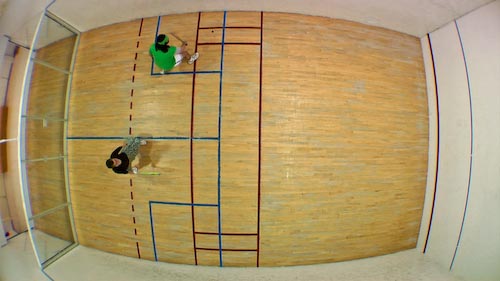by Roger Snodgrass, This article originally published by the Los Alamos Monitor on April 4, 2009

Artist Matthew Day Jackson & Olivia Fermi playing squash, Los Alamos YMCA, April 2009. Still photo from video by Joseph Hung
The granddaughter of one of the Manhattan Project legends, Olivia Fermi visited Los Alamos this week. On Friday, she was in a video shot entirely on a squash court at the YMCA.
“It’s my first time here,” she said. “I’ve wanted to come for a long time.”
Fermi said she had also visited the Bradbury Science Museum and Los Alamos National Laboratory archivist Roger Meade while in town.
With a natural fascination for her brilliant grandfather, Enrico Fermi, she was drawn to participate in a project by Matthew Day Jackson, an artist who lives in Brooklyn.
“The film was Matthew’s conception,” she said.
At first, Jackson was going to call out the physics department of Massachusetts Institute of Technology as an art project, he said. He proposed the Enrico Fermi Challenge, which was meant to be a squash tournament. But that didn’t work out.
Why squash? One connection is that Fermi’s famous atomic pile experiment took place in a converted squash court under the stands at Stagg’s Field at the University of Chicago. Fermi’s achievement of the first controlled self-sustaining nuclear reaction on Dec. 2, 1942, was one of the scientific milestones on the way to the creation of the atomic bomb.
Then it occurred to Jackson that he should play squash with Fermi. But of course, Fermi died in 1954. Maybe he could play squash with a Fermi instead. An Internet search turned up one of the Nobel Laureate’s four grandchildren, Olivia Fermi, a writer-photographer, who lives in Vancouver, British Columbia.
Olivia Fermi is the daughter of Nella, the daughter of Enrico Fermi and Laura Capon, who also had a son, Giulio. Olivia was born after her grandfather died and is the oldest of four grandchildren. She later took on her mother’s maiden name.
She said she had been especially influenced by her grandmother, whose memoir, “Atoms in the Family,” was published in 1954. The book was on the New York Times best-seller list in 1955.
The taping for the video Friday was accomplished in one continuous 30-minute take, using an extremely wide-angle lens on a video camera mounted on the ceiling high above the squash court.
“This is a perfect squash court,” Jackson said of the brightly lit, naturally lighted, high-ceilinged cubicle on the southeast corner of the building.
Fermi doesn’t play squash, but said she learned as they played.
Jackson said, at best he is “very intermediate” as a player.” But they leaped and ran and swung their racquets, giving a personal and physical interpretation, perhaps, of such themes as “sub-critical” and “sustained reaction.”
The filmmaker, artist Joseph Hung, who is also from Brooklyn, checked the replay to make sure the take was continuous and complete.
The cast and crew left for Socorro shortly after the shoot. Olivia Fermi and Jackson timed their trip to be able to take in the Trinity Site in southern New Mexico as well, where the first atomic bomb was tested on July 16, 1945. The site is open to the public twice a year, on the first Saturday of April and October.
Enrico Fermi won the Nobel Prize in Physics in 1938 at the age of 37, for research in radioactivity. Fermi fled Fascist Italy with his Jewish wife Laura and came to the United States after receiving the prize in Stockholm.
Fermi gave a name to the subatomic particle, the neutrino; and fermions, the composite term for the bound state of elementary particles, were named for him. He could estimate almost any calculation in his head, giving rise to the concept of a Fermi Question, which is subject to a quick, ballpark answer that might otherwise be difficult or impossible to answer. The classic example was his solution to the question of how many piano tuners there were in Chicago. The answer is about 125-150, according to whose back-of-the-envelope math one accepts.
Fermi also posed the Fermi Paradox that questioned why, if there were so many possibilities for other life in the universe, we had so far seen no sign of it.
According to a LANL historical note about the squash court experiment, “The achievement of a chain reaction was important, not only because it would prove the principle of the atomic bomb, but also because a chain-reacting pile could be used to produce plutonium, one of the nuclear explosives American scientists hoped to use in their weapons.” The pile was shut down after 28 minutes.


 Twitter
Twitter